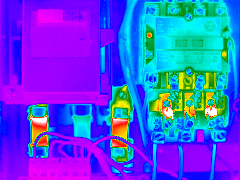Infrared Thermography enables corporations to reduce the risk of unscheduled downtime, increase asset availability and up-time, save money, conserve energy, ensure quality and improve safety.
Reduce Risk

Increase Up-time
Data centers, whether those from banking institutions, insurance agencies or other knowledge providers rely heavily on the health of their primary electrical system, as well as their Uninterruptible Power Supply (UPS) systems which provide back-up in the event of a power loss. Any downtime from an outage can generate financial losses ranging from thousands to many millions of dollars. Up-time is their primary concern. Infrared inspection is being successfully used on a regular basis to check for electrical problems in these systems that, if not detected, could cause costly downtime. This is an example of one of the many thermographic applications that both increases up-time and saves money.
Conserve Energy/Save Money
The cost of conditioning buildings is a concern for both homeowners and facility managers. Infrared thermography and thermal imaging of these structures quickly locates thermal patterns that show the presence of insulation voids and the location of excessive air leakage in both residential and commercial buildings. Applying thermal imaging and thermology to building systems can reveal problems not typically detected with more traditional, and sometimes destructive, testing methods which is why infrared NDT is a viable alternative, Energy auditors and state weatherization groups use thermal inspections on a regular basis to evaluate existing structures and make them more efficient.
Insulators use the IR imaging technology to understand existing buildings prior to insulating and for both new and existing buildings, to verify insulation placement and performance after installation. In commercial and institutional situations, thermography plays huge roles in diagnosing problems and verifying solutions not only for insulation but also for HVAC systems. Thermography, in short, enables building occupants and owners to conserve energy, improve comfort and health, and save money.